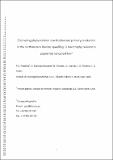Por favor, use este identificador para citar o enlazar a este item:
http://hdl.handle.net/10261/102025COMPARTIR / EXPORTAR:
 SHARE SHARE
 CORE
BASE CORE
BASE
|
|
| Visualizar otros formatos: MARC | Dublin Core | RDF | ORE | MODS | METS | DIDL | DATACITE | |

| Campo DC | Valor | Lengua/Idioma |
|---|---|---|
| dc.contributor.author | Figueiras, F. G. | - |
| dc.contributor.author | Espinoza-González, O. | - |
| dc.contributor.author | Arbones, Belén | - |
| dc.contributor.author | Garrido, J. L. | - |
| dc.contributor.author | Teixeira, I. G. | - |
| dc.contributor.author | Castro, Carmen G. | - |
| dc.date.accessioned | 2014-09-11T11:47:40Z | - |
| dc.date.available | 2014-09-11T11:47:40Z | - |
| dc.date.issued | 2014 | - |
| dc.identifier.citation | Progress in Oceanography 128: 88-97 (2014) | es_ES |
| dc.identifier.issn | 0079-6611 | - |
| dc.identifier.uri | http://hdl.handle.net/10261/102025 | - |
| dc.description | 10 páginas, 3 tablas, 10 figuras | es_ES |
| dc.description.abstract | Primary production of micro- (PPmicro), nano- (PPnano) and picophytoplankton (PPpico) in the NW Iberian margin were estimated by combining biomarker pigments to derive class-specific chlorophyll concentration and published class-specific photophysiological variables for large oceanic scales (Uitz et al., 2008). The accuracy of this approach was assessed comparing the predicted total primary production (PPp = PPmicro + PPnano + PPpico) with the measured total primary production (PPm). Despite the general agreement, PPp overestimated PPm when mixing in the water column was important. Therefore, the photophysiological variables originally derived from stratified and oligotrophic zones with strong influence of photoacclimation in the water column were re-evaluated to incorporate the particular conditions usually found in coastal upwelling systems, characterized by higher homogenization of the water column and lesser importance of photoacclimation. With this new fractionation we estimated the export capacity (f-ratio = new production) of the microbial plankton community, which can be assimilated to the fraction of primary production due to microphytoplankton. The NW Iberian margin showed f-ratios varying between the highest values recorded for coastal upwelling systems (f > 0.75) and the low values usually found in oligotrophic oceanic areas (f < 0.1). This size-fractionated primary production combined with phytoplankton size-fractionated biomass to obtain turnover rates allowed us to infer the existence of mixotrophy within nanophytoplankton. The occurrence of this type of nutrition was indirectly verified by comparing carbon fixation with estimates of gross primary production based on the metabolic theory of ecology. Realistic values of the photosynthetic quotient (PQ = 1.78 ± 0.17; mol O2 mol C−1) were only obtained when heterotrophic nutrition of nanophytoplankton was considered. | es_ES |
| dc.description.sponsorship | This work was funded by the Spanish DYBAGA Project MAR99-1039-C02-01. | es_ES |
| dc.language.iso | eng | es_ES |
| dc.publisher | Elsevier | es_ES |
| dc.rights | openAccess | es_ES |
| dc.title | Estimating phytoplankton size-fractionated primary production in the northwestern Iberian upwelling: Is mixotrophy relevant in pigmented nanoplankton? | es_ES |
| dc.type | artículo | es_ES |
| dc.identifier.doi | 10.1016/j.pocean.2014.08.011 | - |
| dc.description.peerreviewed | Peer reviewed | es_ES |
| dc.relation.publisherversion | http://dx.doi.org/10.1016/j.pocean.2014.08.011 | es_ES |
| dc.relation.csic | Sí | es_ES |
| dc.type.coar | http://purl.org/coar/resource_type/c_6501 | es_ES |
| item.languageiso639-1 | en | - |
| item.fulltext | With Fulltext | - |
| item.openairecristype | http://purl.org/coar/resource_type/c_18cf | - |
| item.cerifentitytype | Publications | - |
| item.grantfulltext | open | - |
| item.openairetype | artículo | - |
| Aparece en las colecciones: | (IIM) Artículos | |
Ficheros en este ítem:
| Fichero | Descripción | Tamaño | Formato | |
|---|---|---|---|---|
| Figueiras_Estimating_phytoplankton_2014.pdf | 1,23 MB | Adobe PDF |  Visualizar/Abrir |
CORE Recommender
SCOPUSTM
Citations
9
checked on 10-abr-2024
WEB OF SCIENCETM
Citations
7
checked on 26-feb-2024
Page view(s)
337
checked on 23-abr-2024
Download(s)
326
checked on 23-abr-2024
Google ScholarTM
Check
Altmetric
Altmetric
NOTA: Los ítems de Digital.CSIC están protegidos por copyright, con todos los derechos reservados, a menos que se indique lo contrario.
